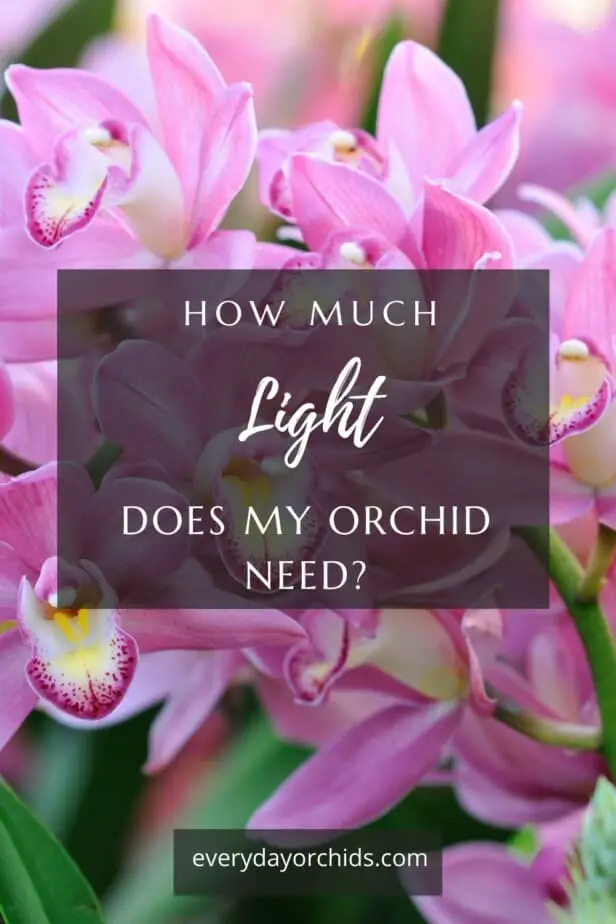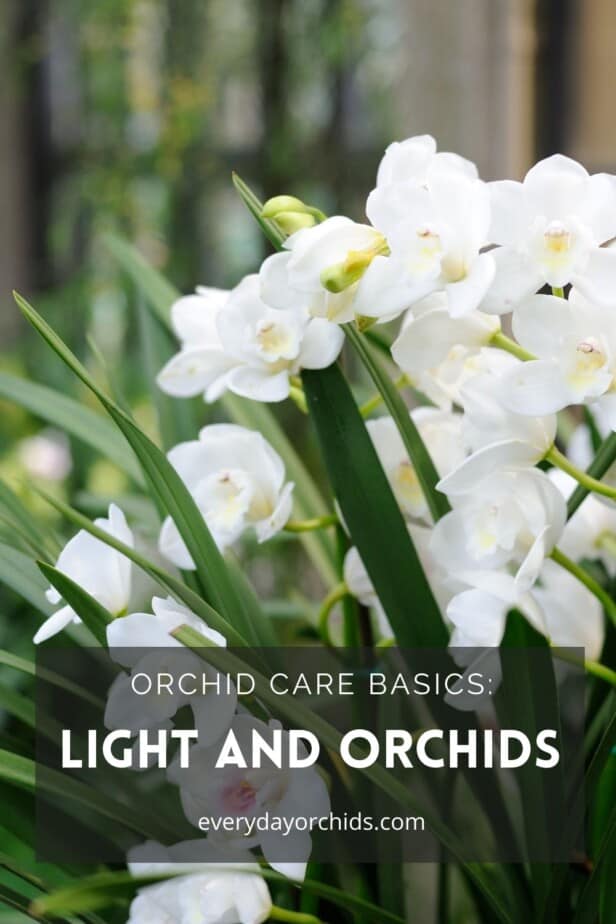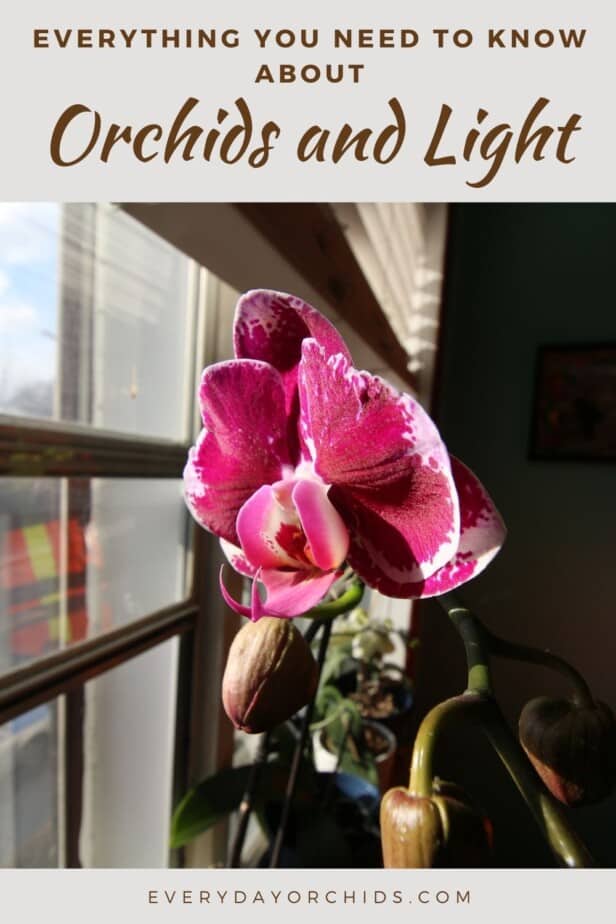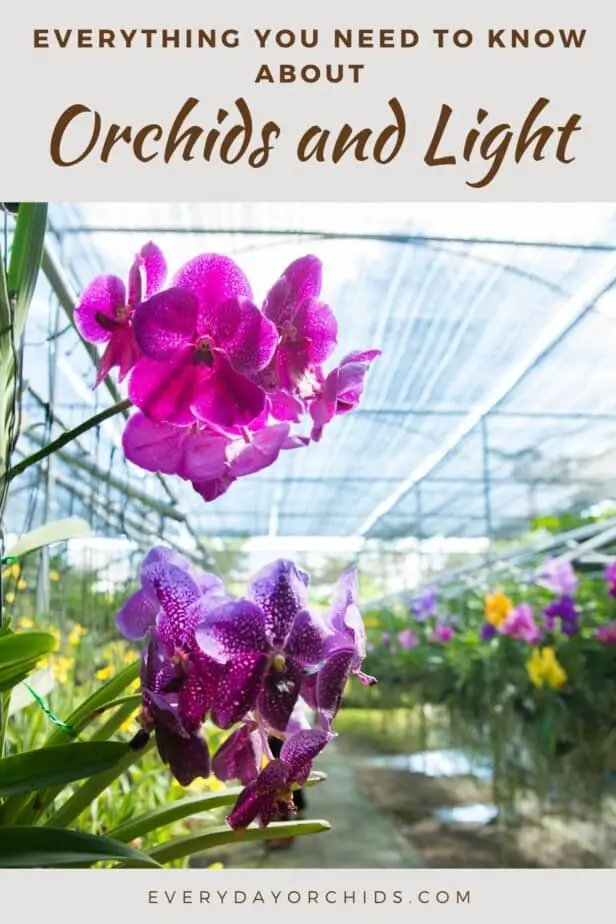Ever wonder how much light your orchid needs? Like all plants, orchids need to be exposed to a minimum number of hours of light each day in order to perform photosynthesis and harvest energy. Orchids can then use that energy to grow leaves, roots and produce blooms.
However, unlike many houseplants, you cannot just set your orchid next to a bright sunny window. More light is not necessarily better. Over time, the bright sunlight may end up burning the leaves or cause the leaves to change color. On the other hand, not exposing your orchid to enough light will result in failure to bloom and other issues.
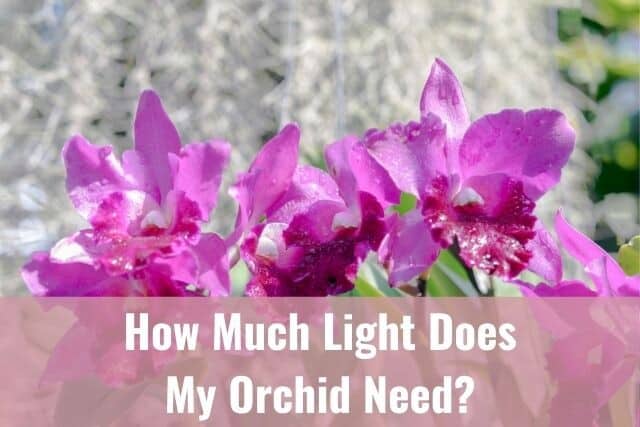
How much light do orchids need? Many orchids require at least 12-14 hours of bright, indirect sunlight each day in order to grow and rebloom. The amount of light and type of light the orchid plant is exposed to can have a wide range of effects on the orchid, from its general health to leaf color and growth. Sufficient light is necessary for your orchid to rebloom.
The issue of lighting, both the amount and the quality, can be confusing for many beginner orchid growers. Some of the common questions beginning orchid growers have include, how much light does an orchid need to thrive? Where is the best place to put an orchid so it gets enough light? How can you even tell if an orchid is receiving enough light?
In this article, I will answer those questions and more. Keep reading to learn more about light and orchid care.
Please note that these links are affiliate links and as an Amazon Associate, I earn from qualifying purchases. Purchases made through affiliate links in this post may generate commissions at no additional cost to you. Use this link for a discounted Amazon Prime trial. Thank you for your support!
Table of Contents
How Much Light Does Your Orchid Need?
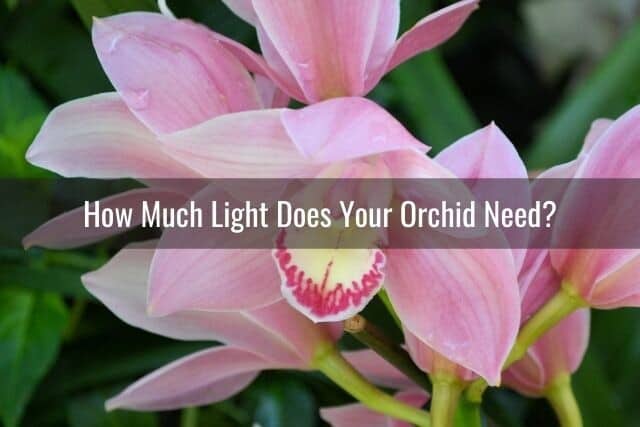
Let’s first address the question of how much light an orchid plant needs. In general, an average of 12-14 hours of bright, indirect sunlight is best for your orchid, year-round.
The type of light each orchid needs will differ depending on the species. Some species of orchids prefer low light, whereas others prefer high levels of light. I will talk more about the preferences for different species later on. The quality of light that an orchid needs also varies according to the type of orchid.
Where Should You Put Your Orchid For The Best Light?
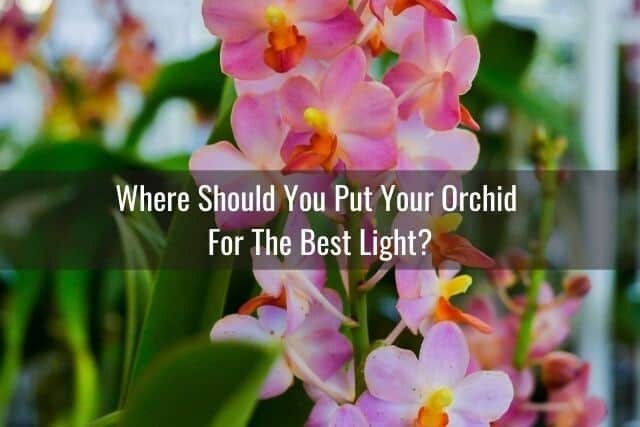
Most beginner orchid growers want to know where is the best place to put their orchid. For most orchid species, south and east-facing windows will be the ideal location for your orchids.
West-facing windows, which receive the intense afternoon sunlight, would provide too much light for an orchid plant. It would also be too hot. You can get around this problem by using curtains and/or moving your orchid further away from the window.
North-facing windows would not allow your orchids to receive enough light. You would generally want to avoid placing your orchids here unless you have an orchid with low light needs.
Remember, in every situation, you can always move your orchids closer or farther away from the window to get the optimal amount of light for your plant.
To determine if you have a south, north, east, or west-facing window, you can point a compass at the window and see what direction the window and compass face. If you do not have a compass (and many people do not), most smartphones these days have a compass app that you can use.
When putting orchids together on a windowsill, keep them spaced apart. This way, that the orchid leaves from different plants will not overlap. By making sure there are no overlapping leaves, you are allowing all the orchid leaves to have equal access to the light. Keeping them spaced apart will also help ensure adequate airflow around and between orchid pots.
Phalaenopsis Orchids
Many orchid owners start out with the Phalaenopsis orchid. The Phalaenopsis orchid, or moth orchid, is commonly sold in supermarkets, flower shops and farmers markets. These orchids are often what most people picture when they think of orchids.
Phalaenopsis orchids prefer low lighting. You can achieve this by placing your orchid near an east-facing window. Morning light that comes through an east-facing window provides bright, yet soft, light for your orchid plant.
If you do not have an east-facing window, you could put your Phalaenopsis orchid near a north-facing window. This is the next best alternative. North-facing windows receive low-to-medium levels of bright, indirect light. This would be fine for many Phalaenopsis orchids.
If your home does not have either east or north-facing windows, and your only alternative is a south or west-facing window, invest in sheer or lightweight curtains to help block out some of the sun. This would allow your orchid to receive enough light without getting burned by the sun’s intense rays.
Paphiopedilum or Lady Slipper Orchids
Paphiopedilum orchids enjoy low to medium levels of light, making them most suited for east-facing windows. North-facing windows are also fine. You want to avoid high intensity light with these orchids, so avoid placing them near a west-facing window.
If you are placing your Paphiopedilum orchid near a south-facing window, you will need to somehow reduce the amount of light. You can use a sheer curtain to cut down on the amount of light coming through the window. Another alternative is to move the orchid further away from the window in the afternoons.
Dendrobium Orchids
Dendrobiums, another type of orchid, thrive in bright light. These orchids like to be placed near lightly covered south-facing windows. By using a thin curtain, you can reduce the intensity of the sunlight coming in. South-facing windows typically receive full sun.
These orchids can also be placed near east or even west facing windows. Just make sure that the orchid is not sitting in direct sunlight. West-facing windows receive the majority of the hot and bright afternoon light. These windows will either need to be lightly covered or the orchid will need to be moved further away from the window.
Leaving an orchid sitting in direct sunlight, whether by a window or outside, may cause the leaves to burn. If not addressed, it could lead to permanent leaf damage. It is always a good idea to keep an eye on the color of your orchid leaves to make sure that your orchid is not receiving too much light.
Oncidium , Cymbidium and Cattleya Orchids
Similar to Dendrobiums, Oncidium, Cymbidium and Cattleya orchids enjoy bright morning light. Some Oncidium varieties can even handle direct, full sunlight. You can place your Oncidium, Cymbidium or Cattleya orchid near a south, east, or even a west-facing window that is covered by a sheer curtain.
These orchids belong to the high light group of orchids and can tolerate high levels of light. Adequate air circulation around the orchids will help regulate temperatures. This will keep the leaves from burning if the orchids are placed near a south or west-facing window.
Light and Flowering in Orchids
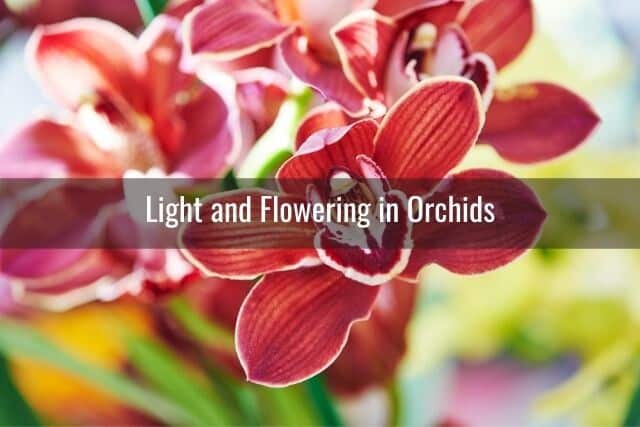
During different times of the year, your orchid will need either more or less light, depending on what growth phase the plant is in.
For example, during dormancy periods, orchids do not require as much light. However, as orchids gear up for flowering and bud production, they require more energy. The way they get this energy is from sunlight. The more hours of sunlight available to the orchid, the more energy they can harvest for use.
Typically, photosynthesis in plants occurs most efficiently in the red and blue peaks of the light spectrum. Photosynthesis also occurs in the greens, yellows and orange areas of the light spectrum. Red light waves help drive photosynthesis the most. Sunlight produces a lot of light in the yellow, green and orange areas of the light spectrum. Green light, while not as effective as red or blue, is critical for photosynthesis in plants.
What does this mean for us? It means that if you have the right wavelengths of light and right kind of light, you can accelerate flowering, increase growth, and improve the health of your orchid.
While your plant may already be doing well, you may be curious about how you can use light from the red and blue spectrum to accelerate growth in your orchids. The answer is artificial lighting. If you live in a house with poor natural lighting, you can complement your orchid area with artificial lighting.
Supplementing with Artificial Lighting
Using artificial lighting is one way to increase available light for your orchids. In fact, some people use only artificial lighting to grow their orchids. There are many options for artificial lighting out on the market. The three main lighting choices are fluorescent bulbs, LED bulbs, and high-intensity discharge lamps. Each option has its own pros and cons.
The main points to remember is that when choosing artificial lighting, you want to ensure that you choose a full-spectrum light bulb. These light bulbs will encompass the red and blue wavelengths of light in addition to the yellow, orange and green wavelengths. Position your lights at least 12 inches away from your plants to avoid heat damage. You will want to leave the lights on for at least 14 to 16 hours each day.
To find out more about how to choose the right type of artificial lighting for your orchid, check out this guide to artificial lighting and orchids.
How Do You Tell What Kind of Light You Have?

Does your room have low, medium or high levels of light? If you are not sure, you can easily figure this out using a quick shadow test.
During the brightest hours of the day, which is usually around noon time, hold your hand about 12 inches over your orchid plant.
If your hand does not make a shadow fall over the plant, you likely do not have enough lighting for your orchid to thrive. While it may be able to continue to grow, it is unlikely that the orchid will be able to rebloom without adequate amounts of light. You will need to move your orchid to a different location with more light.
If your hand makes a very faint gray to light gray shadow, you likely have low to moderate lighting in your room. This should be adequate for a Phalaenopsis orchid.
If your hand creates a dark-gray shadow over the plant, you have high lighting in your room. This would be fine for most Dendrobium, Oncidium and Cattleya orchids. These orchids will enjoy being near the window.
However, if your orchid is a low light loving variety, such as the Phalaenopsis or Paphiopedilum, it would be best to move your orchid away from this high light. You can either use curtains to reduce the amount of light, or move it farther away from the window or into another room altogether.
You may need to observe your orchids for a period of time to ensure that their leaves are receiving adequate amounts of light. Based on the leaf color, you will be able to tell if the amount of light is enough for your orchid.
What Does An Orchid’s Leaf Color Have to Do With Light?
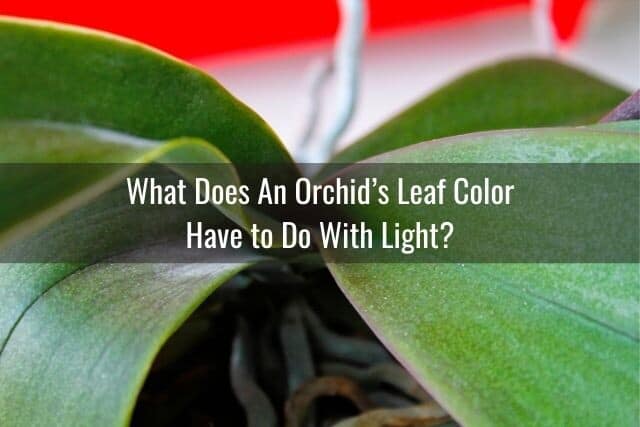
So now you have placed your orchid near a south or east-facing window. It looks like its getting a good amount of light during the daytime. Is this enough? How do you know?
Keep in mind that just because the orchid is in a well-lit room does not necessarily mean that it is getting adequate light. The further away the orchid is from the window, the less light will actually reach the leaves. The best way to tell if your orchid is getting enough light is to look at the leaves.
Oftentimes, orchid leaf color is a good indicator of whether your plant is getting enough light, not enough light, or too much light.
Adequate Light
If the orchid plant is getting enough light, the leaves will be a bright grassy green color. This color is a sign of a healthy orchid leaf. In many cases, the orchid plant has also rebloomed.
Not Enough Light
An orchid plant that is not getting enough light will have dark green leaves. These leaves will be larger and longer. This happens because the plant is trying to create more surface area to receive light. Orchids will do this in order to compensate for the lower overall amount of light the plant receives.
Although the plant may be able to continue to grow, it is unlikely your orchid will be able to rebloom without adequate light. The quickest and easiest solution to this problem would be to move your orchid plant to an area with more light. This may mean moving it closer to the window or to another room altogether. Another solution would be to invest in artificial lighting to supplement the low natural light in your home.
Too Much Light
If you have too much light, you will see yellow-green leaves on your orchid. If this is not addressed in a timely manner, the orchid leaves will become more yellow than green. Then the leaves will start to have white, sunken areas where the leaf has become sunburned. Eventually these white, bleached areas on the leaf will become black or dark brown as the leaf tissue dies.
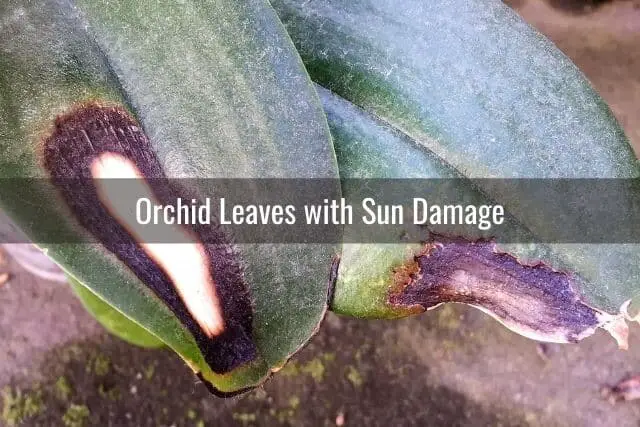
If there are extensive areas of sun damage on multiple leaves, the orchid plant may eventually die. Sunburn damage is irreversible. The best way to avoid this is to move your plant to a shaded area or to an area with less intense light as soon as you see the leaves turning yellow-green.
How Do You Control Lighting if You Keep Your Orchids Outside?
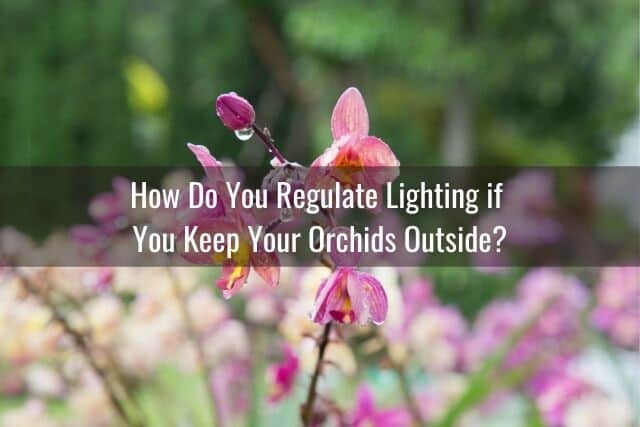
Technically, you cannot control the lighting outdoors because you are at the mercy of the sun, clouds and weather. However, there are ways you can manage the amount of sunlight that hits your orchids by placing them in certain locations outdoors. You can use nearby trees and structures to block the sun. Check out this guide to caring for orchids outdoors for more information.
In general, if you keep your orchids outside, make sure they are in an area where they will be shaded from the sun’s intense light. This is especially important during the noon and afternoon hours of the day.
An ideal outdoor location will allow your orchids to enjoy the morning light, while being shaded from the harsh afternoon sun. Surrounding trees or nearby shrubs can help block the afternoon sun. You can also invest in a sun sail or a shade canopy. This will allow you decrease or regulate the amount of light on your orchids. Some people like to place their orchids under a large tree, allowing the leafy branches to provide filtered light for the orchids.
Outdoor Structures
A gazebo, covered pergola, or any outdoor structure could also provide filtered light and protection for your orchids if you prefer to keep them outdoors.
Personally, I love to keep my orchids outdoors once the weather starts to warm up and nighttime lows no longer drop below 60 degrees Fahrenheit. I place my orchids in an area near the front door where they receive full exposure to morning light. As the day goes on and the sun moves behind the house, the orchids are protected from the full impact of the sun’s afternoon rays. The surrounding trees provides additional protection for the orchids, and my orchids receive filtered light for the remainder of the day.
By being outside in this location, my orchids can benefit from air circulation and natural light. They also remain protected from any direct sunlight that could potentially burn the leaves.
If you do not have an outdoor location like this, you could create your own protected area for your orchids by purchasing shade cloth and a frame at your local hardware store. Using these materials, you can construct a basic shelter and cover it with the shade cloth. You can place your orchids inside this structure, allowing them to be outdoors during warmer weather.
Final Thoughts
While orchids are not difficult to grow, a clear understanding of your orchid’s light needs is essential to successfully care for your orchids and help them rebloom. If you are unsure if your orchid is receiving enough light, you can perform a shadow test or look at the leaf color.
During summer or winter months, you may have to change your orchid’s location in your home to maintain adequate lighting for your orchids. You may even use artificial lighting to achieve this. I talk in depth about setting up artificial lighting for your orchids on Everyday Orchids. Now that you are aware of your orchid’s lighting needs, how to address them, and how to interpret your orchid’s leaf color, you are well on your way to becoming a successful orchid grower.
If you enjoyed this article, please pin it and share!
